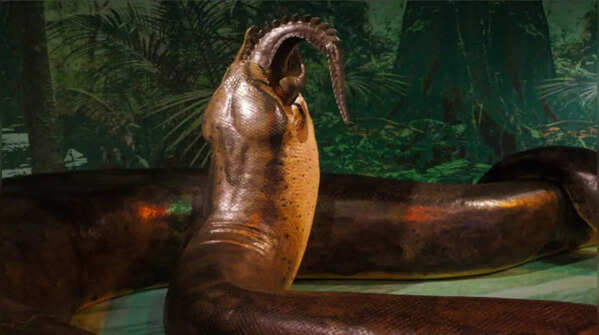47 million years old Vasuki Indicus snake discovered in India: 5 things to know about the snake

47 million years old Vasuki Indicus snake discovered in India: 5 things to know about the snake
Scientists have unearthed the fossil of one of the largest snakes ever to roam the Earth known as the Vasuki indicus that was buried deep beneath the dusty grounds of Gujarat, This massive snake slithered across the earth 47 million years ago remained hidden beneath the sediment layers of the Panandhro Lignite Mine in Kutch.
A team of scientists led by Dr. Sunil Bajpai and Dr. Debajit Datta of the Indian Institute of Technology (IIT) Roorkee conducted a full study and confirmed its identity. This slithering beast has been associated with the Vasuki snake of Lord Shiva, who is the king of nagas and has a ‘nagmani’ on his head. So was Vasuki real or is it just a myth? Here are five must-know facts about this incredible snake.

The discovery nearly took 2 decades
The discovery of Vasuki indicus dates back to 2005, when the first fossils were found at the Panandhro Lignite Mine in Kutch, Gujarat. Researchers uncovered 27 large vertebrae that were well preserved. The lengthy process of studying these fossils took nearly two decades to fully understand the creature’s size, behaviour, and classification. According to the team at IIT Roorkee, the snake is the largest among the snakes that have ever been discovered. Its vertebrae and well-preserved remains were pivotal in identifying its true form.

What is the size and how old is the fossil
Vasuki indicus is estimated to have been a staggering 36 to 50 feet long, making it one of the largest known snakes. With a possible weight approaching one metric tonne, this creature would have been a gigantic figure in its environment. Scientists have confirmed that this snake belonged to the extinct Madtsoiidae family, which consisted of slow-moving giants from the ancient past. The huge size of this snake also gives information about the different environmental conditions, like swamps that existed during the Eocene period.

What did the snake eat?
Though Vasuki indicus was a giant, it wasn’t a venomous predator like many modern-day snakes. Instead, it followed the constriction-to-capture approach to slow down and eat its prey. Similar to today’s pythons and anacondas, this snake would have been a slow-moving ambush predator, patiently waiting for its prey to come within striking distance before launching a powerful attack. Its immense size meant that it could easily overpower massive creatures, such as crocodilians, large turtles, and even early whales that inhabited its aquatic or semi-aquatic environment.
The hunting technique of constriction was particularly effective for a snake of this magnitude. Once it wrapped its muscular body around its prey, the pressure would have been enough to stop blood circulation or suffocate the victim in a matter of moments. Fossil evidence suggests Vasuki indicus thrived during the Eocene epoch, around 47 million years ago, when the Indian subcontinent was rich in biodiversity. Its dominance in the food chain made it one of the apex predators of its time. This prehistoric giant gives scientists valuable insights into snake evolution and how ancient reptiles adapted to their ecosystems.

The massive snake gets its name from Hindu mythology
The name Vasuki indicus comes from the ancient Hindu mythology, where Vasuki is depicted as a mighty serpent king. This powerful and legendary character from Indian tradition shows the strength and cultural significance the creature held, even in ancient times. The name gives the snake an important connection to Indian culture and Hindu scriptures.

It gives information about the prehistoric atmosphere
The discovery of Vasuki indicus isn’t just about the discovery of the giant snake, it’s also a look into what Earth looked like nearly 47 million years ago. Back then, during the Middle Eocene period, the planet was much warmer than it is today. That warmth probably helped cold-blooded creatures like Vasuki grow to such enormous sizes. The area where the snake was found also revealed fossils of turtles, crocodilians, and even early whales that tell about the animals present in and around the surroundings of the snake.

Discovered in Gujarat’s Kutch region
The fossil was found deep inside the Panandhro Lignite Mine in Kutch, Gujarat. Layers of ancient sediment helped preserve this prehistoric giant until it was finally uncovered by scientists.








